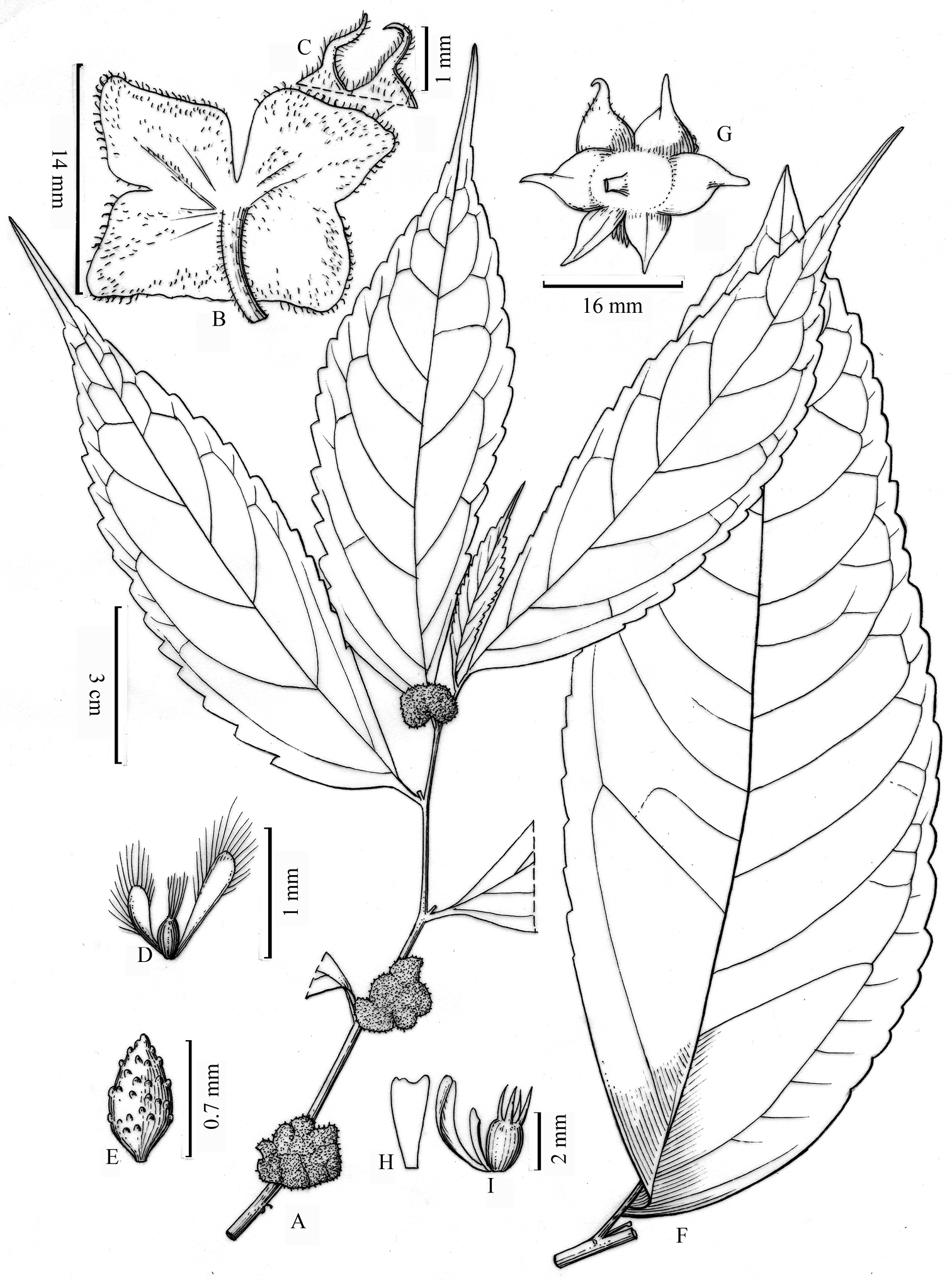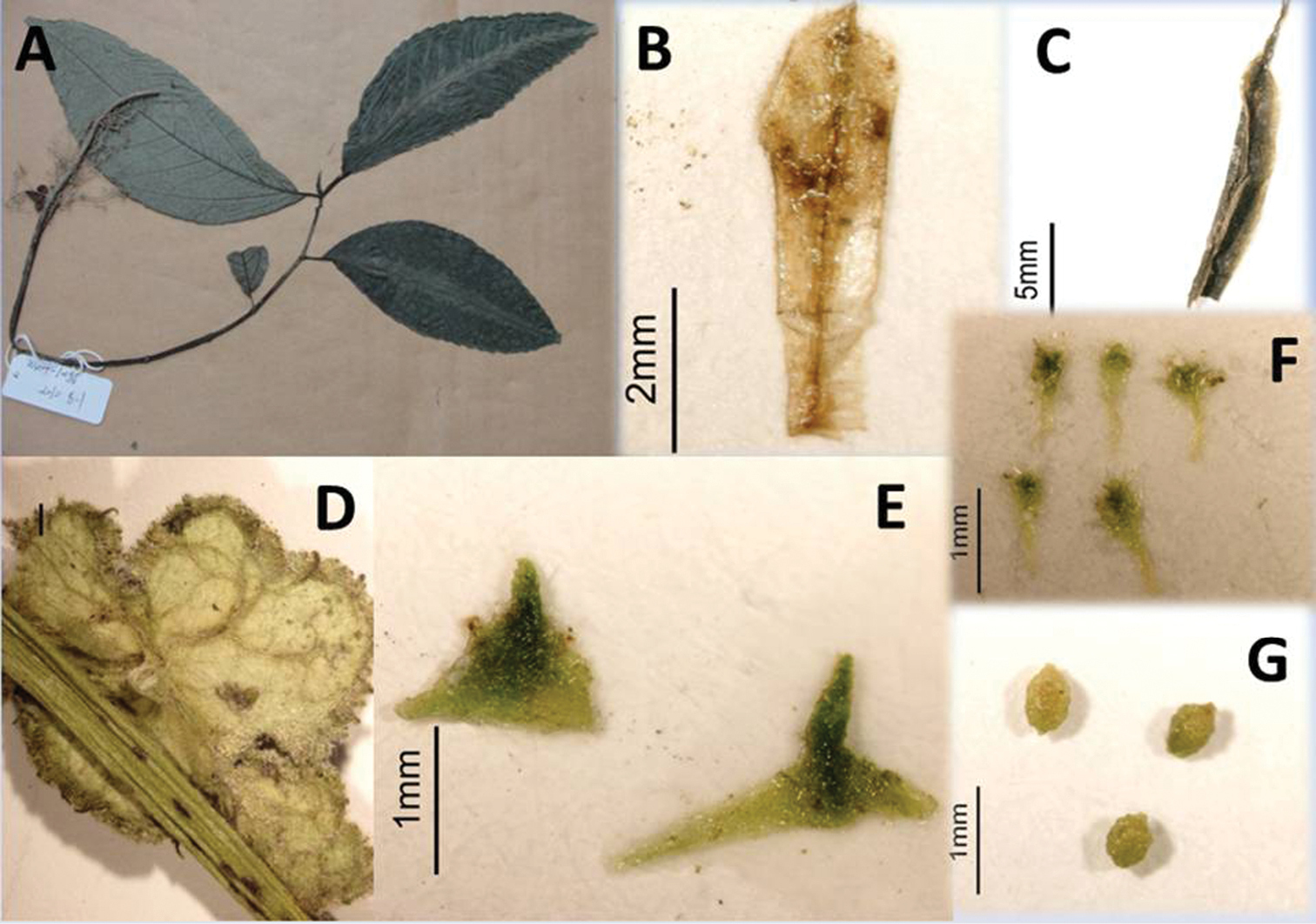






(C) 2011 Zeng-Yuan Wu. This is an open access article distributed under the terms of the Creative Commons Attribution License, which permits unrestricted use, distribution, and reproduction in any medium, provided the original author and source are credited.
For reference, use of the paginated PDF or printed version of this article is recommended.
Elatostema pleiophlebium and Elatostema malipoense, two endemic species from southeast Yunnan of China, are described and illustrated. Their diagnostic characters, description and relationship with morphologically similar species are also given. Elatostema pleiophlebium is easily recognised by its glabrous stem and leaf blade, and its longitudinally 1-ribbed outer staminate bracts. Elatostema malipoense is morphologically distinct for its tuberculate achene and pistillate receptacle which is puberulous. Both new species are known only from their type localities, and they are proposed to be classified as critically endangered.
China, Elatostema, new species, Urticaceae, Yunnan Province
The genus Elatostema J. R. Forst. & G. Forst. is one of the largest genera of the family Urticaceae. This genus is characterized by the perianth lobes of female flowers being much shorter than the ovary or strongly reduced, and not corniculate at apex (
Elatostema comprises ca. 550 species distributed in tropical and subtropical Africa, Asia and Oceania, especially in humid areas (
urn:lsid:ipni.org:names:77116005-1
http://species-id.net/wiki/Elatostema_pleiophlebium
Fig. 1F–I, 2A–COb foliorum nervos laterales plures et capitula staminata 6-bracteata glabra species nova haec est fortasse affinis Elatostema quinquecostato W.T.Wang, quod caulibus strigosis, foliis apice cuspidatis supra hispidis subtus strigosis nervos laterales utrinsecus usque ad 12-14 ferentibus, capituli staminati bracteis duabus exteris dorso 5-costatis et infra apicem breviter corniculatis praeclare differt.
China. Yunnan, Hekou county, Nanxi village, Sanchahe river, 22°41'4"N, 103°59'26"E, 388 m, 01 Aug. 2010, Z. Y. Wu 10181 (Holotype: PE!; Isotype: PE!); the same locality, 01 Aug. 2010, Z. Y. Wu 10186 (Paratype: KUN!).
Perennial herb. Stems erect, 30-50 cm tall, glabrous, unbranched. Stipules narrowly lanceolate or lanceolate, 5–14 × 1.5–3 mm, with cystoliths 0.5–0.7 mm long, apex pungent; leaves shortly petiolate, glabrous, petioles 3–17 mm long; leaf blade chartaceous, obliquely narrowly ovate, broadly oblong or elliptic, 10–20 × 4.5–7.2 cm, glabrous, adaxial surface with 1 broad, interrupted, white stripe along the mid vein, adaxial surface with dense cystoliths, conspicuous, bacilliform, 0.25–0.8 mm long, penninerved, narrow side with (4-) 7–10 lateral nerves, broad side with (5-) 7–11 lateral nerves, base obliquely cuneate, margin denticulate, apex acuminate, shortly acuminate or obtuse. Staminate capitula solitarily axillary, glabrous; peduncle ca. 1.5 mm long; receptacle broadly oblong, ca. 8 × 6 mm; bracts 6, 2-seriate, ovate or narrowly ovate, abaxially above longitudinally 1-ribbed, with rib apex extended into subulate horn-like projections, outer 2 opposite, larger, 4–5 × 9 mm, with apex projection 3 mm long, inner 4 smaller, 4–5 × 5–7 mm, apex projection 1–1.5 mm long; bracteoles membranous, numerous, semihyaline, above brownish, obtrapezoid or navicular, 2–3.2 × 0.6–2 mm, above slightly conduplicate, apex cucullate. Staminate flower buds subsessile, broadly obovoid, ca. 2 mm long, glabrous, apex 4-corniculate. Female flowers and achenes not known.
Elatostema pleiophlebium is a forest understory herb. In the type locality, it occurs on wet ground in forest close to a river where it is associated with Elatostema alnifolium and some species of Musa, Ficus andPiperaceae.
Elatostema pleiophlebium is known only from the type locality near the Sanchahe river, Nanxi village, Hekou county, Yunnan. Consequently, it is probably an endemic species. A single population of a few hundred individuals was observed in an area of 1 km2. We believe therefore, that this new species is on the verge of extinction but we do not know if population size is stable or declining. Following the IUCN red list criteria (
Elatostema pleiophlebium is a member of series Nanchuanensia W.T.Wang in sect. Elatostema (
The epithet ‘pleiophlebium' refers to the numerous lateral nerves characteristic of the leaves of this species.
A–E Elatostema malipoenseW. T. Wang & Zeng Y. Wu. A Upper part of flowering pistillate stem B pistillate capitulum, seen from below C two pistillate involucral bracts D pistillatate bracteoles and pistillate flower E achene, (based on Z. Y. Wu 10347). F–I Elatostema pleiophlebium W.T.Wang & Zeng Y.Wu. F upper cauline leaf G staminate capitulum H staminate bracteole I staminate bracteoles and staminate flower bud, (based on Z. Y. Wu 10181).
urn:lsid:ipni.org:names:77116006-1
http://species-id.net/wiki/Elatostema_malipoense
Figs 1A–E, 2D–GOb folia penninervia et capituli pistillati bracteas numerosas apice corniculatas species nova haec est similis Elatostema pseudobrachyodonto W.T.Wang, quod foliis supra puberulis, capituli pistillati receptaculo glabro, bractearum pistillatarum cornibus apicalibus majoribus 1.5-2 mm longis, bracteolis pistillatis viridibus minoribus 0.3–0.6 mm longis apice breviter ciliatis, acheniis longitudinaliter 4-costatis valde recedit.
China. Yunnan, Malipo county, Xiajinchang village Yunling, 23°10'6"N, 104°49'50"E, 1613 m, 05 Aug. 2010, Z. Y. Wu 10347 (Holotype: PE!; Isotype: KUN!).
Perennial herb. Stems erect, 30-50 cm tall, above sparsely short- puberulous near the node, unbranched. Stipules subulate or narrowly triangular, 0.1–0.2 mm long; leaves shortly petiolate, glabrous, petioles 1–6 mm long; leaf blade subchartaceous, obliquely oblong or narrowly obovate-oblong, 11–15 × 3–3.5 cm, both surfaces densely short strigose, cystoliths conspicuous, dense, bacilliform, 0.1–0.2 mm long, penninerved, lateral nerves 5–7-paired, base obliquely cuneate, apex cuspidate (entire), margin denticulate. Pistillate capitula solitarily axillary; peduncle ca. 8 mm long, short-puberulous; receptacle subquadrate or broadly oblong, 10–15 × 10–15 mm, 4-lobulate or irregularly 4–6-lobulate, short-puberulous; bracts ca. 75, deltoid or depressed-deltoid, 0.5–0.6 × 0.5–0.7 mm, ciliate, abaxial surface short-puberulous, apex with a subulate horn-like projections, 0.7–1 mm long; bracteoles membranous, whitish, semihyaline, narrowly obovate or oblanceolate, 0.5–1 mm long, apically long ciliate. Pistillate flower subsessile, tepals absent; pistil 0.8 mm long, ovary green, 3.5 mm long, stigma penicillate, ca. 4.5 mm long. Achenes ovoid, 0.6–0.7 × 0.4 mm, densely tuberculate. Staminate capitula not seen.
Elatostema malipoense is a scattered understory herb growing in moist clay soils in shady sites or near ravines at an altitude of ca. 1600 m, associated with Pilea insolens and some species of Ficus.
Elatostema malipoense is an endemic species and has only been collected from the type locality around Xiajinchang village Yunling, Malipo county, Yunnan, where a population of ca. 200 individuals was observed in an area of 1 km2. According to IUCN red list criteria (
Elatostema malipoense is a member of sect. Elatostema (
The species epithet ‘malipoense' is derived from the name of the type locality, Malipo County, Yunnan Province, China.
A–C Elatostema pleiophlebium W.T.Wang & Zeng Y.Wu. A Specimen B staminate bracteole C stipule D–G Elatostema malipoense W.T.Wang & Zeng Y.Wu. D pistillate capitulum, seen from below E pistillate involucral bracts F pistillate bracteoles G achenes.
This study was financially supported by the National Natural Science Foundation of China (grant no. 40830209). The authors also acknowledge financial support from the Yunnan Provincial Department of Science and Technology (grant no. 2008GA029). We are grateful to Ying-Bao Sun for the botanical drawings. We are indebted to Jie Liu, Ram C. Poudel and Alex K. Monro for their valuable comments and language corrections, to two anonymous reviewers and Hanno Schaefer for their helpful suggestions, to Wen-Fang Zhang and Zhao-Ming Cai for their great help during the field work.

